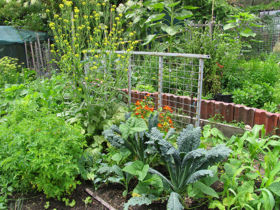Food/Permaculture
Most of the food produced nowadays in the industrialized world comes from large centralized farms that focus on a small number of crops or animals. These agricultural systems require a constant input of fertilizer, pesticide, water and other resources, and have a constant output of pesticide-contaminated runoff water and other waste.
By contrast, permaculture creates an interconnected system of flora and fauna that recycles its own resources. It is an designed ecosystem rather than a factory-style production outfit.
On a permaculture farm, there may be chickens that eat weeds and fertilize plants with their droppings. Food waste and inedible parts of plants are used as fertilizer. The output of the system thus becomes input. There is (theoretically at least) no waste, allowing the system to be 'permanent', able to go on for millenia without adversely affecting the local ecosystem. A properly designed permaculture system will make the soil more fertile year after year.
Another principle of permaculture is multiculture, growing many different plants and animals side-by-side, so that they feed off one another's resources. The different part of the system are balanced in dynamic equilibrium. Multiculture allows higher food yields with less work than monoculture and provides humans with a greater variety of foods.
Each element in a permaculture system serves multiple purposes. For example, herbs may be used in cooking, but they also host predatory insects that control pests.
Permaculture is not only an ecologically sound means of food-production, it is very efficient. Permaculture expert David Blume claims to have grown food for 300 people on two acres of land [1] - equivalent to less than 20m2 per person.
While not as automated as the aeroponics techniques described to the left, permaculture is a highly practical and advanced methodology that can play a role in making Spaceship Earth work for everybody.
